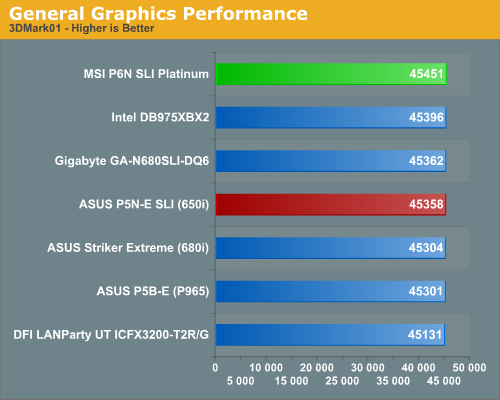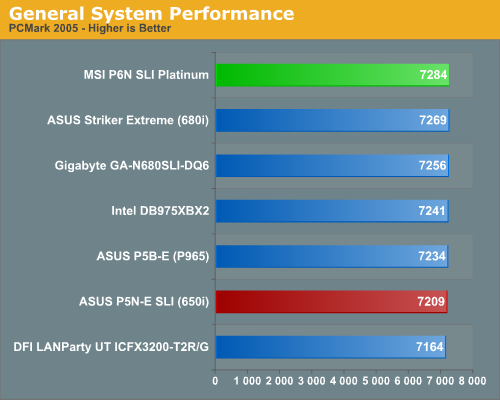MSI P6N SLI Platinum: NVIDIA's 650i Part Two
by Gary Key on March 13, 2007 1:00 AM EST- Posted in
- Motherboards
Synthetic Graphics Performance
The 3DMark series of benchmarks developed and provided by Futuremark are among the most widely used tools for benchmark reporting and comparisons. Although the benchmarks are very useful for providing apples-to-apples comparisons across a broad array of GPU and CPU configurations they are not a substitute for actual application and gaming benchmarks. In this sense we consider the 3DMark benchmarks to be purely synthetic in nature, but they are still very valuable for providing consistent measurements of performance.


In our 3DMark06 test, each platform score is basically the same, though we see the DFI RD600 based motherboard trailing slightly. We attribute this to the slightly lower memory and video performance results in our latest BIOS release. Our MSI board tops the chart and offers the best CPU performance of our test boards in this benchmark.
In the more memory and CPU sensitive 3DMark01 benchmark we see our MSI 650i board topping the Intel 975X board, but the Sandra memory bandwidth results still greatly favor the 975x platform. Our Sandra memory bandwidth scores along with Memtest86 testing also consistently show the RD600 performing slightly better than the 680i or 650i, but our 3DMark01 benchmark does not show this advantage. Generally, NVIDIA based chipsets perform very well in graphics tests and the scores from our MSI P6N SLI Platinum indicate a highly tuned platform. We will see this pattern continue for the most part in our other tests.
Synthetic System Performance
The PCMark05 benchmark developed and provided by Futuremark was designed for determining overall system performance for the typical home computing user. This tool provides both system and component level benchmarking results utilizing subsets of real world applications or programs. This benchmark is useful for providing comparative results across a broad array of Graphics subsystems, CPU, Hard Disk, and Memory configurations along with multithreading results. In this sense we consider the PCMark benchmark to be both synthetic and real world in nature, and it again provides consistency in our benchmark results.

The MSI 650i board once again tops our charts is very competitive in this benchmark, although we expected slightly better results based upon our application results. The 650i and 680i chipsets scored very well on the single task disk benchmarks and both performed almost equally on the graphics subsystem tests where they led the field. However, our 975X and P965 chipset boards won the multitasking tests while the RD600 finished in the middle on most of the tests.
The 3DMark series of benchmarks developed and provided by Futuremark are among the most widely used tools for benchmark reporting and comparisons. Although the benchmarks are very useful for providing apples-to-apples comparisons across a broad array of GPU and CPU configurations they are not a substitute for actual application and gaming benchmarks. In this sense we consider the 3DMark benchmarks to be purely synthetic in nature, but they are still very valuable for providing consistent measurements of performance.


In our 3DMark06 test, each platform score is basically the same, though we see the DFI RD600 based motherboard trailing slightly. We attribute this to the slightly lower memory and video performance results in our latest BIOS release. Our MSI board tops the chart and offers the best CPU performance of our test boards in this benchmark.
In the more memory and CPU sensitive 3DMark01 benchmark we see our MSI 650i board topping the Intel 975X board, but the Sandra memory bandwidth results still greatly favor the 975x platform. Our Sandra memory bandwidth scores along with Memtest86 testing also consistently show the RD600 performing slightly better than the 680i or 650i, but our 3DMark01 benchmark does not show this advantage. Generally, NVIDIA based chipsets perform very well in graphics tests and the scores from our MSI P6N SLI Platinum indicate a highly tuned platform. We will see this pattern continue for the most part in our other tests.
Synthetic System Performance
The PCMark05 benchmark developed and provided by Futuremark was designed for determining overall system performance for the typical home computing user. This tool provides both system and component level benchmarking results utilizing subsets of real world applications or programs. This benchmark is useful for providing comparative results across a broad array of Graphics subsystems, CPU, Hard Disk, and Memory configurations along with multithreading results. In this sense we consider the PCMark benchmark to be both synthetic and real world in nature, and it again provides consistency in our benchmark results.

The MSI 650i board once again tops our charts is very competitive in this benchmark, although we expected slightly better results based upon our application results. The 650i and 680i chipsets scored very well on the single task disk benchmarks and both performed almost equally on the graphics subsystem tests where they led the field. However, our 975X and P965 chipset boards won the multitasking tests while the RD600 finished in the middle on most of the tests.










20 Comments
View All Comments
ranutso - Wednesday, March 21, 2007 - link
Great article. Thank you Gary.cosmotic - Wednesday, March 14, 2007 - link
How can you say that MSI software is decent? It's totally hideous. I think Anandtech owes it to the community to encourage motherboard manufactures to start writing native-feeling Windows applications instead of these crap piles all the manufactueres are shipping now. This includes AMD/ATI, nVidia, Realtek, and many others for their drivers as well.Gorgonzola - Thursday, June 21, 2007 - link
I could not agree more!anandtech02148 - Wednesday, March 14, 2007 - link
Here I go againcomplaining about the psu and power consumption, but 300watts load,200watts idle,
not to mention fancy subwoofer, a few electronics here there,
good gaming is in the summer time, and i'll be cranking up the AC too which is another 250wtts.
i wish newegg.com would sell me a n.korean light water nuclear reactor so i can run all my greatest hardwares.
Spanki - Wednesday, March 14, 2007 - link
Hey Gary,Since it looks like this mb outperforms pretty much every other board in the review in most tests (at stock speeds, where head-to-head comparisons usually take place) - including the much touted 'Extreme' board(s), do you plan to include it for comparisons in future reviews?
Olaf van der Spek - Tuesday, March 13, 2007 - link
The 650i uses 21% more power on idle compared to the ICFX3200. What is nV doing with all that power? This seems absurd.Gary Key - Tuesday, March 13, 2007 - link
It is being channeled into the on-board Flux Capacitor. ;-) I can tell you that we have hounded NVIDIA to no end about this issue with their chipsets. It should be addressed when they finally go to a single chip solution later this year (we are still hoping this occurs).
Frumious1 - Tuesday, March 13, 2007 - link
If I were to venture a guess, NVIDIA probably isn't doing any proper power savings work for the chipset. Just like with CPUs and GPUs, there's a lot of stuff on the chipset that is often not in use and can be put into a sleep/deep sleep mode. The 650i and 680i use 100-107W more power at full load than at idle. The 975X uses 141W more at load, P965 139W more, and RD600 105W more.IIRC, AMD is using a newer process technology for RD600, so that would help explain their lower overall power. Intel seems to benefit from power savings in idle mode, but at full load they are pretty close to NVIDIA. The extra "stuff" in 680i relative to 650i could easily account for the added ~10W that it requires. Seems to me like all companies involved could do more with chipset power savings. AMD is just ahead on the process tech (again, I think); Intel uses an older process but decent power saving circuitry; NVIDIA doesn't do anything to conserve chipset power.
When you consider that at idle the PC is doing nothing important, AMD and Intel should drop CPU clocks further (600 MHz ought to be enough), and they could drop FSB/bus speeds and chipset voltages as well. Why run 1066FSB when you're doing essentially nothing? Why run 1000MHz HyperTransport to transfer... nothing? I believe AMD does drop HT speeds at idle on their mobles chips, so why not on desktop offerings?
Just my two cents.
WT - Tuesday, March 13, 2007 - link
Patiently awaiting the Gigabyte version of this board, as I was most interested in upgrading to the 965DS3 board rev 3.3, but the 650 look like it is worth the wait. Also, since the C2D price drop isn't until late April, I have time to wait and make a decision once that board is available. Good read as usual guys !ghitz - Tuesday, March 20, 2007 - link
Exactly what I was thinking !!